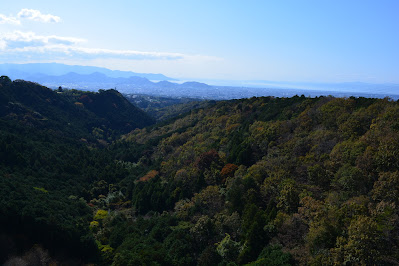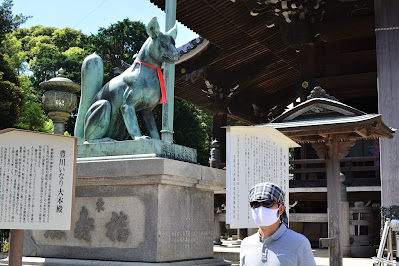Hubby and I visited Mount Gozaisho on 13th October. Mount Gozaisho is located on the border of Higashi Omi in Shiga prefecture and Komono in Mie prefecture. This mountain is the center of Suzuka Quasi National Park, and is the highest mountain in the park. Gozaisho Ropeway connects the top of the mountain to Yunoyama Hot Spring at the base area. Mount Gozaisho is well known for fall colors which begin at the summit in mid-October, and travel down the mountain to the hot spring area at the base over a period of one month. Fall leaves with a blended combination of red, yellow, and green progress gradually over time from the summit to the base of the mountain. We visited the mountain to ride on Gozaisho Ropeway and enjoy the fall colors.
Thursday, December 17, 2020
Mount Gozaisho and Gozaisho Ropeway
Friday, November 20, 2020
Mishima Skywalk and Mount Fuji
Hubby and I visited Mishima Skywalk in Mishima city of Shizuoka prefecture on November 11, 2020. Mishima Skywalk is a suspension bridge with a scenic view from where we can see Mount Fuji in the far background. The bridge has a total length of 400 meters and is the longest pedestrian suspension bridge in Japan.
Saturday, October 10, 2020
Toyokawa Inari Temple
On 24th September, hubby and I visited Toyokawa Inari Temple. It is a Buddhist temple of Soto Zen sect and is located in Toyokawa city of Aichi prefecture. The formal name of the temple is Enpukuzan Toyokawa-kaku Myogonji. The temple is sprawled over an area of 127300 square meters and was founded in 1441 by a Buddhist priest named Tokai Gieki. His distant predecessor Kangan Giin studied Tantric Buddhism in China in the 13th century. According to him Juichimen Kannon is an avatar of a female deity named Toyokawa Dakinishinten. On a rough sea-trip home from China, Kangan Giin had a vision of Dakinishinten riding atop a white fox while carrying a sheaf of rice and a wish-fulfilling jewel. After he settled down in Japan, he himself carved a beautiful image of the deity, which is now housed in the main hall of the temple. People pray to the deity for good business, for having many children and other worldly benefits. The temple was patronized in the Sengoku period as well as Edo period by great warriors like Oda Nobunaga, Toyotomi Hideyoshi, and shogun Tokugawa Ieyasu.
At a cursory glance it seems like the temple has elements of both Buddhism and Shinto religions. Although many structures in the temple premises like Torii Gates, statues of Kitsune fox, and the deity itself with an image of goddess (Inari Okami) riding a messenger white fox are generally associated with Shinto religion, it is purely a Buddhist temple with no overt association with Shinto. The similarity was most likely created during the period of religious syncretism in the initial period of Meiji Restoration, and the line between Buddhism and Shinto was blurred that time.
It is very interesting to note that Goddess Dakini is known as a wrathful form of Goddess Kaali in Tantric Hinduism in India. It is very likely that Goddess Dakini was incorporated into Japanese Buddhism and evolved into Dakinishinten. In modern folk belief, the image of fox is thought to be a substitute for the Indian jackal usually associated with Kaali.
We entered Toyokawa Inari Temple through a majestic gate named Somon. After the founding of the temple, Somon Gate was first renovated after 214 years in 1656. The present gate was reconstructed in 1884 in Irimoya-zukuri (hip and gable roof) style. It is a four pillared gate with a gable. The gate has double doors made from a single plate of zelkova wood that is believed to be from a tree that is more than 1000 years old. The doors are 4.5 meters high, 1.8 meters in width, and 15 centimeters thick. The gate has copper roofing and has hand-carved metal fittings at various places. Somon is an ornate wonderful gate.
On entering the temple premises, we saw a stone Torii Gate to our left. Two statues of Kitsune foxes on either side of the gate looked amazing. The foxes are made of copper and stand on stone pedestals. The Torii gate and the foxes are considered to be the typical identifying elements of Shinto religion. This clearly shows that the line between Buddhism and Shinto was blurred during the Meiji Restoration period.





































































